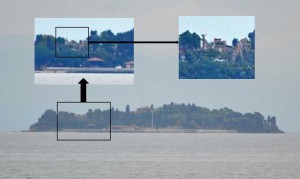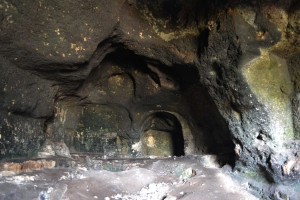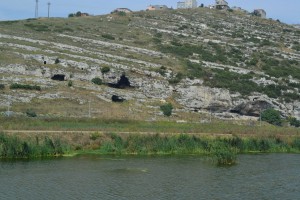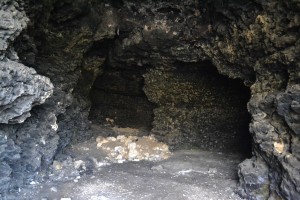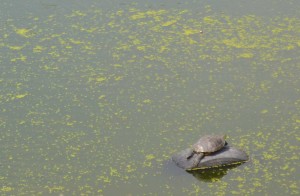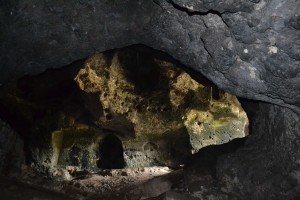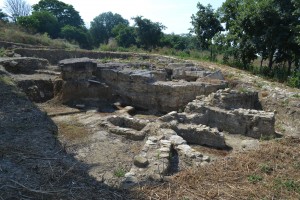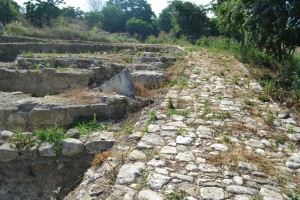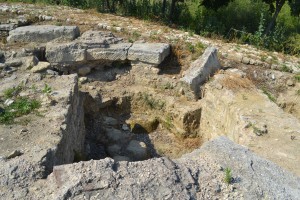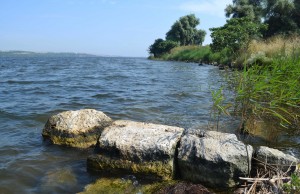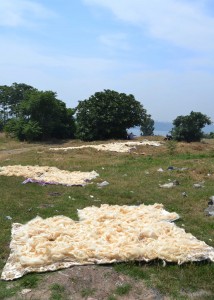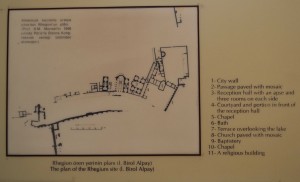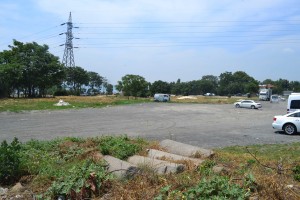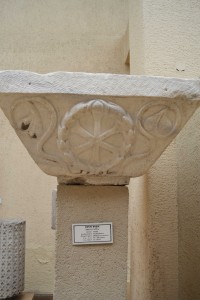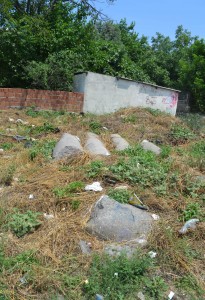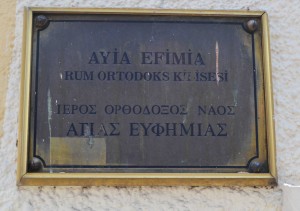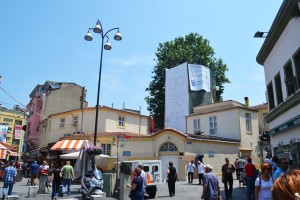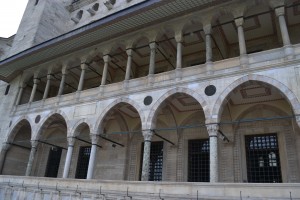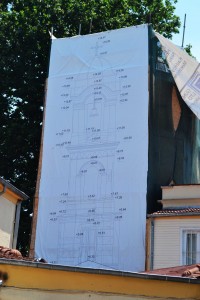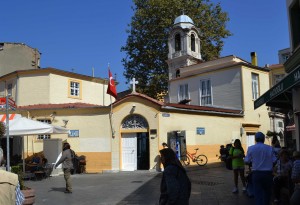On an island a few hundred metres off the coast of Tuzla are the well-preserved remains of the Byzantine Church of St. Glykeria (Hagia Glykeria Nesos, 40.791212,29.274938). However, the island is owned by Rahmi Koç and this limits access somewhat. The island may once have been called Incirli Adası but now is invariably called Koç Adası. There is some information here.

Posted June 25, 2014 Posted by Adam in Uncategorized
This may be Istanbul’s most significant archaeological site. It is primarily of interest for its evidence of hominid settlement in the Pleistocene and there has been a lot of study of the cave bear bones found inside, especially their relationship with Palaeolithic weapons that might have killed them.
Human habitation continued until Byzantine times and there is a church cut into the rock in the upper cave. This is superficially similar to the Aya Nikola Monastery in Kıyıköy and Mamboury advances the idea that this was a church of St Theodore. The whole place is a minefield of archaeological argument but it is a wonderful place to explore. The protection of the iron grilles installed to prevent people entering is minimal as the gap between bars allows even me to enter, let alone those with the more lean physiques normally associated with youthful vandalism. However, the main damage has been done by film crews for whom this is a common location. Yusuf and Emir, the young guardians of the cave, listed a Who’s Who of Turkish actors whom they had seen filming here. They told me the legend of the tunnel in the lower cave that allegedly goes all the way to Topkapı Palace. It goes about 600m (in roughly the right direction, admittedly). There were once some spectacular wall paintings there that did not survive until the 21st century.
Across the Sazlıdere River is another cave belonging to the same settlement. There is little of importance here, but the grilles are much more secure. The river itself appears polluted but the old car tyres are favoured by a large population of turtles which like to sun themselves on them.
The access situation has changed as of September 2016. The grilles have been repaired and not even small boys can get through. I arrived at the site and almost immediately a Zabita van from Başakşehir Belediyesi arrived. Three uniformed policemen got out, shook my hand and unlocked the gate to the cave. Apparently, you can call 444 0 669 and someone will come and let you in. The advantage of this is that vandalism and treasure-hunting excavations are no longer destroying what is left in the cave. The downside is that you can’t stay in the cave for very long and extended exploration of the long tunnel with its bats and calcite formations will now require tedious official preparation.
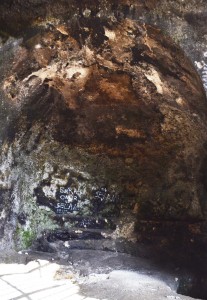
Apse with synthronon of church near entrance of upper chamber
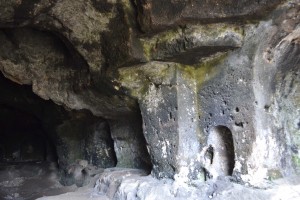
South wall of upper chamber showing extensive Byzantine remains
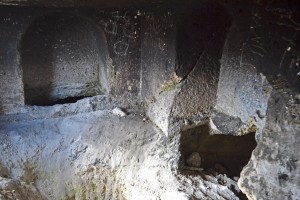
Necropolis with three large burial chambers about 12m above the main chamber
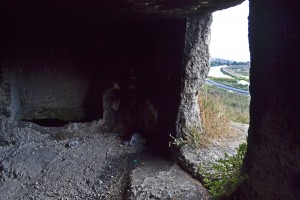
View south from necropolis along Sazlıdere towards Küçükçekmece
Arsebük, G., F.C. Howell, S.L. Kuhn, W.R. Farrand, M. Özbaşaran, M.C. Stiner. (2010) Chapter 1: The caves of Yarımburgaz: Geological context and history of investigation. In (Howell et al., Eds.) Culture and Biology at a Crossroads: The Middle Pleistocene Record of Yarimburgaz Cave (Thrace, Turkey). Zero Books/Ege Publications, Istanbul, pp. 1-27. Available online at: https://www.academia.edu/969121/Chapter_1_The_caves_of_Yar%C4%B1mburgaz_Geological_context_and_history_of_investigation Accessed Sept 1 2016(2010)
Arsebük, G., F.C. Howell, M. Özbaşaran, (1998) Yarımburgaz “1988” in XI Kazı Sonuçlar Toplantası I. T.C. Kültür Bakanlığı Anıtlar ve Müzeler Genel Müdürlüğü pages 9 – 38 Available online at: http://www.kulturvarliklari.gov.tr/sempozyum_pdf/kazilar/11_kazi_1.pdf Accessed Sept 4 2016
TAY Project (2000) Yarımburgaz Mağarası. The Archaeological Settlements of Turkey. http://www.tayproject.org/TAYmaster.fm$Retrieve?YerlesmeNo=2826&html=masterengdetail.html&layout=web Accessed Sept 4 2016

Posted June 25, 2014 Posted by Adam in Uncategorized
There is a large expanse of farmland on the north-east coast of Küçükçekmece. This is an oasis in the proliferating forests of giant apartment blocks in other districts surrounding the lake and probably remains as it is because it is owned by various government institutions, especially the veterinary faculty of Istanbul University. This is slightly odd because the area operates as a grain farm and I saw no animals at all.
I am not sure whether or not I was allowed in. One has to go through two automated gates to enter the archaeological site (41.032913,28.734226). I went at harvest time. The gates were probably open to allow the monstrous combine harvesters in. On my way out, the gates were closed. I got out of the car to look at them and an unseen presence in the nearby buildings opened them for me.
It’s a big site and only partially excavated. A Scientific American article gives some detail. It seems to have thrived between the 4th and 11th centuries. An earthquake ended its importance. Its long sea wall is largely submerged, as are a lot of remains of the city. Bathonea is almost certainly not the correct name, although a more accurate candidate is yet to surface. At present, the site seems to be deserted except for the most enormous toads.

Posted June 25, 2014 Posted by Adam in Uncategorized
The shallow lake to the west of Istanbul has not been seen as a desirable location in the last few decades. However, it used to be a magnet for recreation seekers, including Atatürk. Further back, when the lake provided a nice stop on the Via Egnatia, the road to Constantinople, this was a flourishing town of opulent summerhouses for the rich. Mamboury studied the extensive remains to the south-east of the lake (40.987422,28.777431) and claimed that this was the Byzantine town of Rhegium. Later researchers identify it as Roman Bathonea. The remains are thin on the ground now. Four and a half columns buried by dumped grass mowings. These probably come from one of the churches or chapels that made up a fair proportion of the imperial compound.
Still, when you look from the columns over the field of drying wool to the blue water of the lake, you can get a vague idea of what a good site this was for a palace. Better preserved remains on the relatively uninhabited north-west shore (41.032978,28.734012) have been labelled as part of Rhegium but other researchers call this area Bathonea. Whatever the name, this area has been settled for a long time, as remains associated with Pleistocene hominids in Yarımburgaz Cave (41.074563,28.742815) testify.
- Four and a half columns

Posted June 25, 2014 Posted by Adam in Uncategorized
St Euphemia, an important saint in Orthodox hagiography, was probably the world’s second most famous virgin. She was tortured for her Christianity and, as the final trial of her martyrdom, was thrown to some particularly tolerant lions who merely licked her wounds. A bear, presumably a beast against which the protective power of virginity counted for naught, eventually finished her off.
It is St Euphemia who is to blame for the great split in the Orthodox Church that occurred at the Council of Chalcedon in 451. The Miaphysites and the Dyophysites wrote down their statements of belief and laid them reverently on the breast of the saint in her tomb at Chalcedon. Three days later Euphemia was holding the scroll with the Diaphysite statement in her right hand while the other was at her feet. Since then the Oriental Orthodox community (Armenian, Coptic, Syriac, Ethiopian) pretend that the council did not happen and only recognise the first three Ecumenical Councils.
The church in which the council was held seems to have been destroyed in a Persian invasion in about 626. Euphemia’s remains had apparently been moved to the new Martyrium in Sultanahmet. Whatever church was built to take its place was in a condition of disarray when plundered for columns by Sinan in his quest for building materials for the Süleymaniye. The current church was built in the middle of Kadıköy Market (40.990633,29.024908) in 1694 and has been extensively burnt, damaged, rebuilt and renovated since. The walls are very, very yellow. The company doing the current renovation has provided a handy guide to the dimensions of the tower should the good people at Miniatürk wish to construct a replica.
The tower is once again out of scaffolding and providing a focal point for the life in the Kadıköy community.

« Previous Entries
